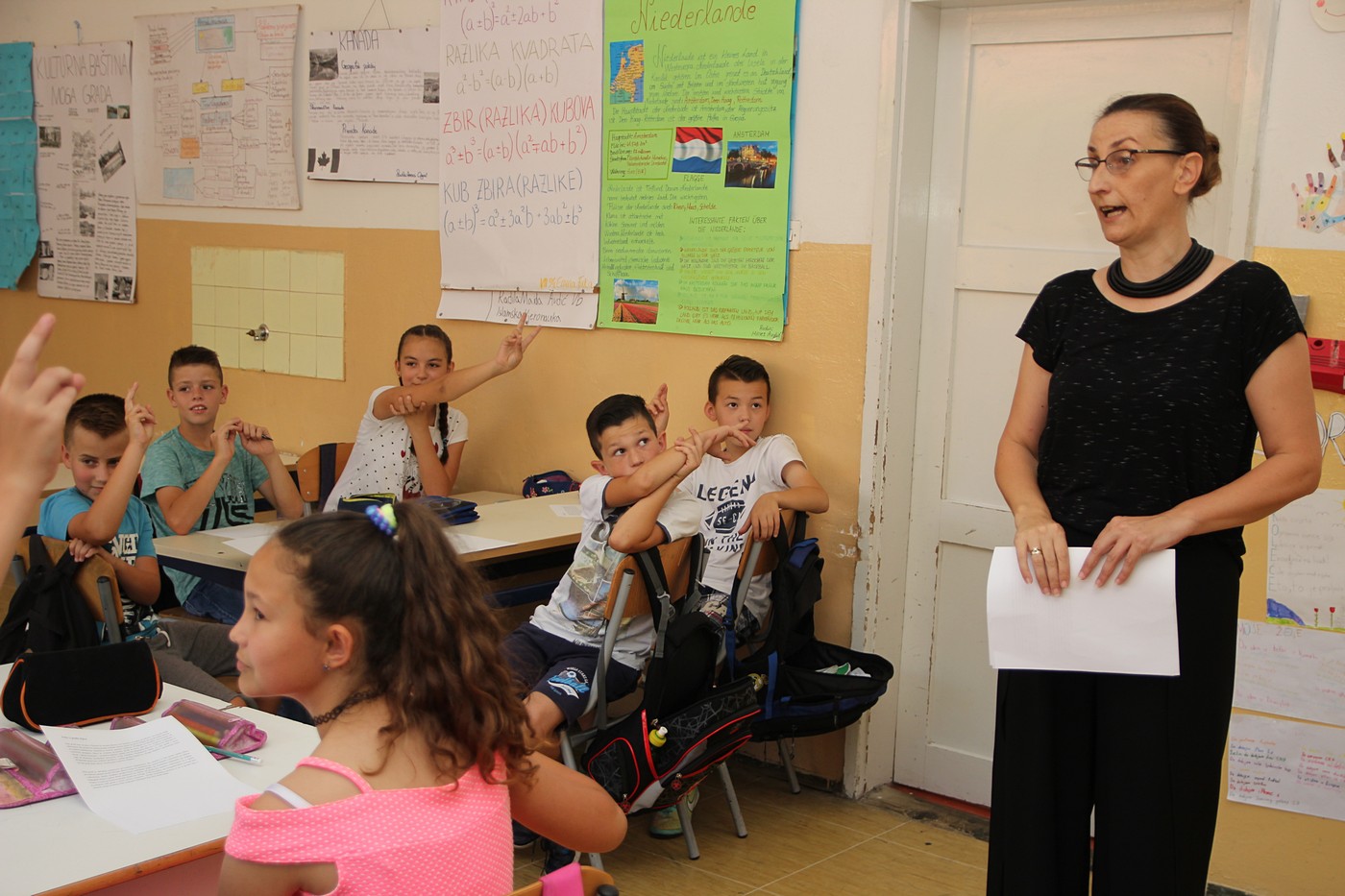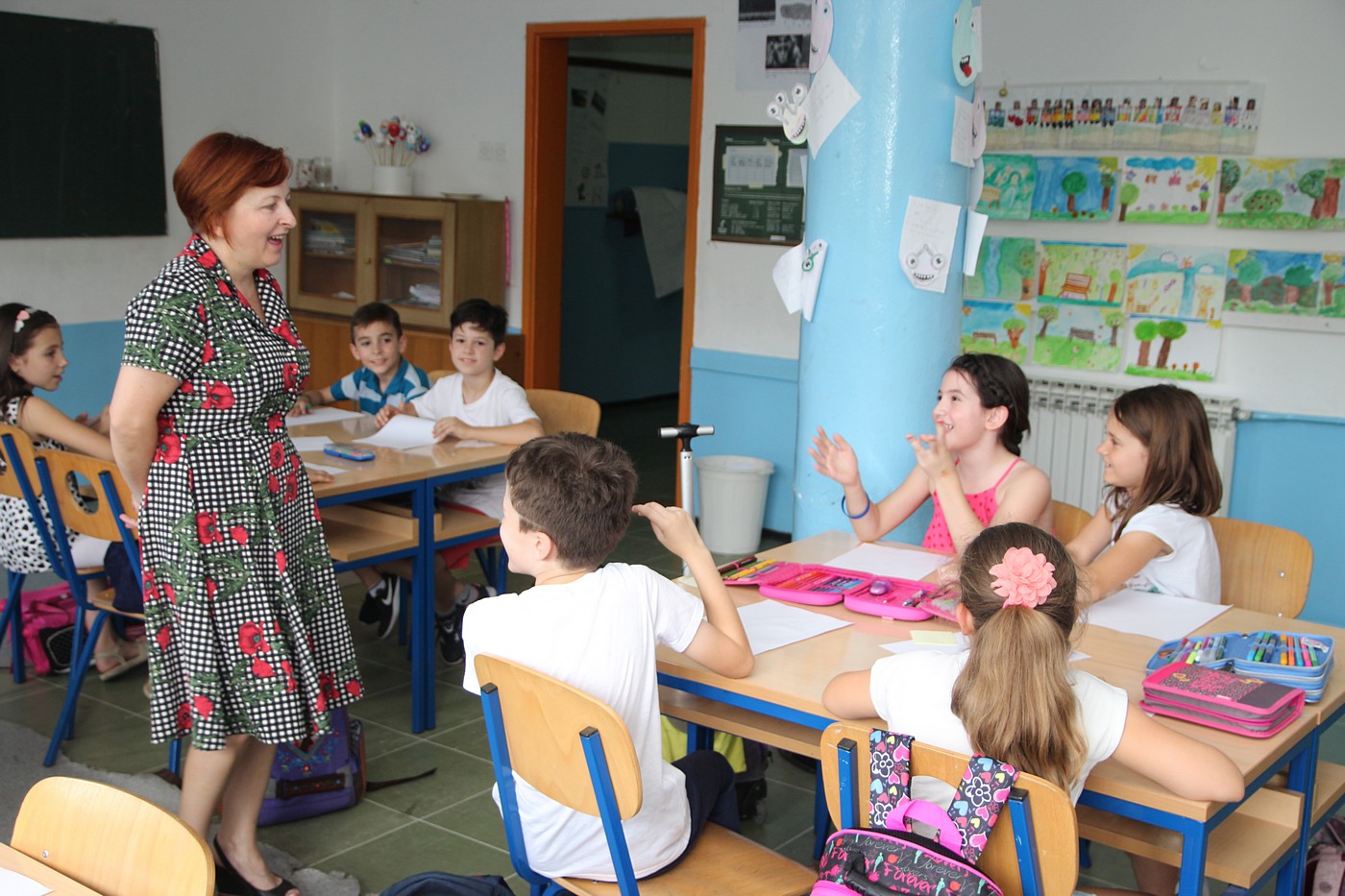 North West Balkans
North West Balkans
Languages
ACQUIRING KNOWLEDGE AND COMPETENCES FOR THE FUTURE
“It was fun working in a group and playing a detective. We worked and decided what was right in the story about a poplar and travellers together. It is better when we get to an answer together”, said Afan, a pupil of the IIa class of Malta Primary School in Sarajevo after a class taught by Amina Serdarevic, a teacher, who used teaching methods based on student learning outcomes.
Student learning outcomes as an approach to teaching means basing the curricular concept and content, including the work and evaluation, on an assessment of integrated knowledge, skills and values both students and society need. Under this approach, the ability to demonstrate what has been learned is key. Children are encouraged to express their critical views and solve a task through collaborative work.
“This form of teaching requires that children get engaged, think and make conclusions under the coordination and facilitation by the teacher, who is no longer the only source of knowledge the children listen to or learn from. We live in the times of laptops, tablets and smart phones. Given this environment, it is necessary to develop a teaching process that would encourage verbal communication in children, which is, unfortunately, reduced due to modern technologies; this approach to teaching achieves it”, said teacher Amina Serdarevic.
The girls and boys from the 5b class, focused on resolving a task at hand - to come up with a title for a text they had been sent by their friends from Jajce - did not hear the school bell that marked the end of the class with teacher Adnela Tihak in the First Primary School in Stolac. We attended her class and watched her using teaching methods based on learning outcomes. It was a mother tongue class discussing the topic “informative text”. With their greetings, the children’s friends from Jajce had sent a text about their town and asked them to help with the title of the text.

The children read the text together, in a group, talked about the best title for it, and then a group representative read it out. In the text, they found a lot of information about Jajce, where it was situated; they looked at a map to find the Pliva River and Vrbas River into which it flows, and thus combined their knowledge from several school subjects.
“A teacher is someone who moderates a class, where children read, explore, share their conclusions together and come to understand that there are no wrong answers; they are encouraged to express their views and use the views of others to reach a final conclusion. They will certainly memorise and learn a conclusion much better this way than when being told one”, explained teacher Adnela.
“I love classes like this with teacher Adnela, they are more fun than classes where we just sit and listen. We work in groups together and the time passes quickly. For the next class, I’ll gather more information about the Old City and mediaeval tombstones, which I’d like to share with my friends in another town”, told us Bakir, a student from the 5b class in the First Primary School in Stolac.
Izabela Vricic-Draskovic from the Third Elementary School in Mostar had been a teacher for 25 years. She told us that she found the student learning outcomes based teaching, which she had started applying after a series of specialised training programs discussing the introduction of this form of teaching, quite useful and innovative.
“Despite the ample experience I’ve acquired working in schools, I had no reservations in respect of the new methods - quite to the contrary, I’m curious by nature and always eager to learn something new and improve my work. In the beginning, I had expectations, but they were exceeded. I apply what I learnt to my teaching, most often when working on an informative text to develop reading, verbal, listening skills...”, told us teacher Izabela Vricic - Draskovic.
“In addition to the realisation of teaching units, we use these methods when realising different thematic projects in different school subjects; the children pick up a topic, we bring the material and they get down to work. They learn and I’m there to coordinate; the class is dynamic from the very beginning to the end, and the class does not always end with the school bell but when they have finished. Everyone is active, everyone has something to say or add, they acquire knowledge together, and they’ll memorise best what they’ve concluded themselves”, explained Izabela Vricic - Draskovic, and her third-graders had already formed groups and were waiting for the school bell to mark the start of a class where they would analyse an informative text on the topic “the Sun”. Earlier, they had worked on topics such as earthquakes, airplanes, astronauts...

“I like this class because we all work and learn together how to cooperate and we get to learn a lot. Today, I’ve learnt a lot about the Sun, things I didn’t know before”, said Emanuela, and Klara added that she liked that way of learning because a lot could be learnt during the class.
“Every time we read something in the class and when we want to learn more, then the teacher explains it and we learn new things together”, said Klara.
“This method of teaching results in knowledge a child can apply in further education and everyday life. Children are taught how to work as a team, where everyone achieves the same goal in a different way - there are no wrong questions and no wrong answers”, said Lejla Knezovic, a pedagogue in the Third Primary School in Mostar, adding that way, encouraged to share their critical views, children would overcome any fear from oral examination and volunteer more often. All that could result in better grades.
Save the Children NWB supports institutions in the reform of the educational system by developing common curricular cores for the areas of language, mathematics, science and art based on learning outcome. Save the Children has supported the development of common curricular cores and is now working on the introduction and implementation of learning outcomes for the areas of language and mathematics; it supports educational authorities review curricula to reflect the outcome-based learning approach.
“This is about a different structuring of a class. The focus of the activities is on the student now. The aim is to modify teaching methods so that teachers guide students towards higher levels of knowledge, where students are not required to reproduce what they have learnt but to analyse, apply in practice and resolve problems in innovative and creative ways. We are convinced that these competences are important for the future of girls and boys in Bosnia and Herzegovina”, noted Andrea Zeravcic, Director of Save the Children NWB.
As part of a pilot project implemented in Zenica - Doboj Canton in the period 2013 - 2015, this innovative approach to teaching, based on learning outcomes, was methodologically presented to key experts from education ministries, pedagogical institutes, the academic community, preschool / kindergarten educators, teachers from elementary schools and, most importantly, children.
Drawing on the success of the pilot project, Save the Children rolled over the successful approach, which went beyond the pilot project; the plan is to introduce teaching based on learning outcomes in two areas - language and mathematics - in six administrative areas in BiH using the already recognised model of implementation, which rests on three pillars: training of trainers, rolling over through replication training and monitoring programs, and introducing the model in curricula while ensuring system-wide sustainability.
Text & photo: Almir Panjeta/Save The Children